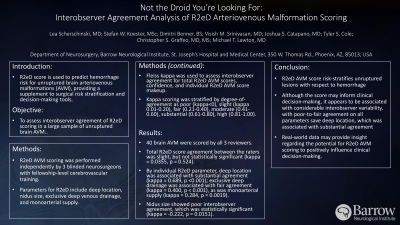Not the Droid You’re Looking For: Interobserver Agreement Analysis of R2eD Arteriovenous Malformation Scoring
Not the Droid You’re Looking For: Interobserver Agreement Analysis of r2ed Arteriovenous Malformation Scoring
Friday, April 21, 2023

.jpg)
Lea Scherschinski, MD
Postdoctoral Research Fellow
Barrow Neurological Institute
Phoenix, Arizona, United States
ePoster Presenter(s)
Introduction: R2eD score is used to predict hemorrhage risk for unruptured brain arteriovenous malformations (AVM), providing a supplement to surgical risk stratification and decision-making tools. This study assesses interobserver agreement of R2eD scoring in a large sample of unruptured brain AVM.
Methods: R2eD AVM scoring was performed independently by 3 blinded neurosurgeons with fellowship-level cerebrovascular training. Parameters for R2eD include deep location, nidus size, exclusive deep venous drainage, and monoarterial supply. Fleiss kappa was used to assess interobserver agreement for total R2eD AVM scores and individual R2eD AVM score makeup. Kappa scoring was stratified by degree-of-agreement as poor (kappa < 0), slight (kappa 0.01-0.20), fair (0.21-0.40), moderate (0.41-0.60), substantial (0.61-0.80), and high (0.81-1.00).
Results: 40 brain AVM were scored by all 3 reviewers. Total R2eD score agreement between the raters was slight, but not statistically significant (kappa = 0.0355, p = 0.524). By individual R2eD parameter, deep location was associated with substantial agreement (kappa = 0.689, p < 0.001); exclusive deep drainage was associated with fair agreement (kappa = 0.400, p < 0.001), as was monoarterial supply (kappa = 0.284, p = 0.0019). Nidus size showed poor interobserver agreement, which was statistically significant (kappa = -0.222, p = 0.0151).
Conclusion : R2eD AVM score risk-stratifies unruptured lesions with respect to hemorrhage. Although the score may inform clinical decision-making, it appears to be associated with considerable interobserver variability, with poor-to-fair agreement on all parameters save deep location, which was associated with substantial agreement. Real-world data may provide insight regarding the potential for R2eD AVM scoring to positively influence clinical decision-making.
Methods: R2eD AVM scoring was performed independently by 3 blinded neurosurgeons with fellowship-level cerebrovascular training. Parameters for R2eD include deep location, nidus size, exclusive deep venous drainage, and monoarterial supply. Fleiss kappa was used to assess interobserver agreement for total R2eD AVM scores and individual R2eD AVM score makeup. Kappa scoring was stratified by degree-of-agreement as poor (kappa < 0), slight (kappa 0.01-0.20), fair (0.21-0.40), moderate (0.41-0.60), substantial (0.61-0.80), and high (0.81-1.00).
Results: 40 brain AVM were scored by all 3 reviewers. Total R2eD score agreement between the raters was slight, but not statistically significant (kappa = 0.0355, p = 0.524). By individual R2eD parameter, deep location was associated with substantial agreement (kappa = 0.689, p < 0.001); exclusive deep drainage was associated with fair agreement (kappa = 0.400, p < 0.001), as was monoarterial supply (kappa = 0.284, p = 0.0019). Nidus size showed poor interobserver agreement, which was statistically significant (kappa = -0.222, p = 0.0151).
Conclusion : R2eD AVM score risk-stratifies unruptured lesions with respect to hemorrhage. Although the score may inform clinical decision-making, it appears to be associated with considerable interobserver variability, with poor-to-fair agreement on all parameters save deep location, which was associated with substantial agreement. Real-world data may provide insight regarding the potential for R2eD AVM scoring to positively influence clinical decision-making.
